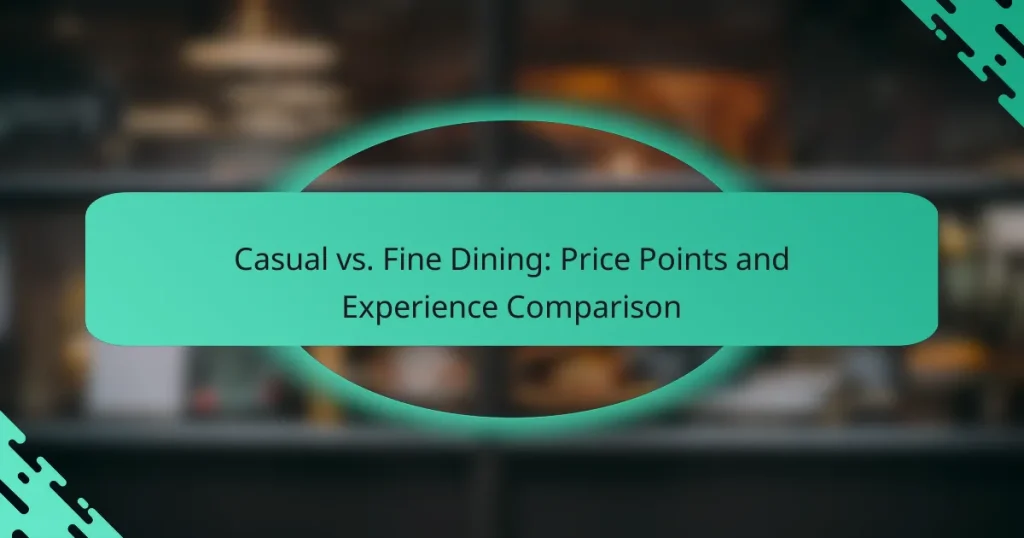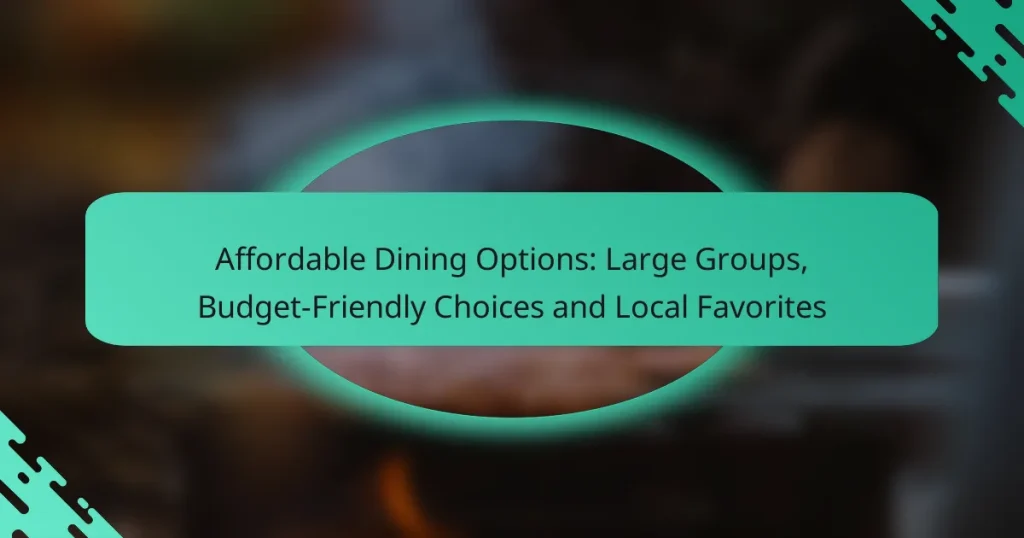Understanding restaurant service pricing is essential for diners looking to make informed choices about their dining experiences. Prices can vary significantly based on factors such as cuisine type, location, and the quality of ingredients used. Casual dining may cost between $15 and $30 per person, while fine dining can exceed $100, highlighting the diverse options available to suit different budgets and preferences.
Value for Money: Local Dining Experiences and Cost Analysis
Loyalty Programs: Discounts, Benefits and Frequent Diners
Dining Budget: Restaurant Selection and Cost Considerations
Casual vs. Fine Dining: Price Points and Experience Comparison
Affordable Dining Options: Large Groups, Budget-Friendly Choices and Local Favorites
What are the average restaurant service prices in Los Angeles?
The average restaurant service prices in Los Angeles vary widely based on the type of dining experience. Casual dining typically ranges from $15 to $30 per person, while fine dining can exceed $100 per person. Fast food and food trucks offer more budget-friendly options, generally under $15.
Casual dining pricing
Casual dining establishments in Los Angeles often charge between $15 and $30 per person, depending on the menu and location. This price range usually includes an entrée, a drink, and possibly an appetizer or dessert. Popular chains and local favorites alike fall into this category, making it accessible for most diners.
When choosing a casual dining spot, consider factors like portion sizes and any additional costs for sides or drinks. Happy hour specials can also provide significant savings.
Fine dining pricing
Fine dining in Los Angeles typically starts at around $50 per person and can easily exceed $100, especially at high-end restaurants. This pricing often reflects the quality of ingredients, chef expertise, and overall dining experience. Tasting menus and wine pairings can further increase the total cost.
For those looking to enjoy fine dining, it’s advisable to check for prix fixe options or special events that may offer a more affordable way to experience gourmet cuisine.
Fast food pricing
Fast food prices in Los Angeles usually range from $5 to $10 per meal, making it an economical choice for quick dining. Most fast food chains offer combo meals that include a main item, fries, and a drink within this price range.
Keep an eye out for value menus and promotions, which can provide even greater savings. However, be mindful of portion sizes, as they can vary significantly between different chains.
Food truck pricing
Food trucks in Los Angeles generally charge between $8 and $15 for a meal, depending on the cuisine and location. These mobile eateries often feature unique and diverse offerings, making them popular among locals and tourists alike.
When visiting food trucks, consider trying a few smaller items to sample different flavors, as many trucks offer smaller portions or combo options at a discounted rate.
Delivery service pricing
Delivery service prices in Los Angeles can vary widely, often adding a fee of $3 to $10 on top of the meal cost. Many restaurants also charge a service fee for delivery, which can be a percentage of the total order. Additionally, tips for delivery drivers are customary and should be factored into the overall cost.
To save on delivery, look for restaurants that offer free delivery promotions or consider ordering directly from the restaurant instead of through third-party apps, which may charge higher fees.
How do restaurant service prices vary by cuisine type?
Restaurant service prices can differ significantly based on the type of cuisine offered. Factors such as ingredient costs, preparation complexity, and regional popularity play a crucial role in determining these prices.
Italian restaurant pricing
Italian restaurants often feature a range of pricing, typically from moderate to high. Dishes like pasta and pizza can be affordable, often ranging from $10 to $20, while more elaborate meals, such as seafood risotto or osso buco, may cost between $25 and $50.
When dining at an Italian restaurant, consider the cost of wine, which can add significantly to the overall bill. Many establishments offer wine pairings that can enhance the meal experience but may also increase your total expenditure.
Mexican restaurant pricing
Mexican restaurant pricing is generally accessible, with many casual dining options offering meals between $8 and $15. Traditional dishes like tacos and enchiladas are often budget-friendly, while specialty items, such as mole or seafood dishes, can range from $15 to $30.
Be mindful of additional costs for sides like guacamole or queso, which can elevate your bill. Happy hour specials are common in Mexican restaurants, providing opportunities for lower-priced appetizers and drinks.
Asian restaurant pricing
Asian restaurants, encompassing a variety of cuisines such as Chinese, Japanese, and Thai, exhibit diverse pricing structures. Sushi and sashimi can be on the higher end, often costing $15 to $40 for a full meal, while noodle and rice dishes typically range from $10 to $20.
Consider the type of dining experience; all-you-can-eat sushi places may offer lower prices per dish but can lead to higher overall costs if not managed well. Look for lunch specials, which are often more economical than dinner menus.
American restaurant pricing
American restaurant pricing varies widely, with casual diners offering meals from $10 to $25 and upscale establishments charging $30 and up. Burgers and sandwiches are usually more affordable, while steak and seafood options can significantly increase the total cost.
When dining in American restaurants, keep an eye out for daily specials or combo meals that provide better value. Tipping is customary, typically around 15-20% of the total bill, which should be factored into your overall dining budget.
What factors influence restaurant service pricing?
Restaurant service pricing is influenced by several key factors, including location, service level, and ingredient quality. Understanding these elements can help diners make informed choices about where to eat and what to expect in terms of value.
Location impact
The location of a restaurant significantly affects its pricing structure. Restaurants in urban areas or popular tourist destinations often charge higher prices due to increased rent and operational costs. In contrast, establishments in rural or less-trafficked areas may offer lower prices to attract customers.
Additionally, local economic conditions can influence pricing. For example, a restaurant in a high-income neighborhood may set higher prices compared to one in a more economically diverse area, reflecting the purchasing power of the clientele.
Service level differences
Service levels can vary widely between restaurants, impacting overall pricing. Fine dining establishments typically provide a higher level of service, including attentive waitstaff and a more formal atmosphere, which can justify higher menu prices. Casual dining or fast-casual restaurants may offer a more relaxed service experience, often resulting in lower prices.
When evaluating service levels, consider factors such as wait times, staff-to-customer ratios, and the overall dining experience. Higher service levels often come with premium pricing, but they can enhance the overall value of the meal.
Ingredient quality
The quality of ingredients used in menu items plays a crucial role in determining restaurant pricing. Restaurants that prioritize fresh, organic, or locally sourced ingredients typically charge more, as these options often come at a higher cost. Conversely, establishments that use frozen or mass-produced ingredients may offer lower prices.
When assessing ingredient quality, look for menus that highlight sourcing practices. Restaurants that emphasize high-quality ingredients may provide a better dining experience, making the higher prices more justifiable for discerning customers.
How can restaurants provide value to customers?
Restaurants can provide value to customers by enhancing their dining experience through various strategies that foster satisfaction and loyalty. Key methods include implementing customer loyalty programs, offering seasonal promotions, and ensuring high-quality service.
Customer loyalty programs
Customer loyalty programs reward repeat patrons, encouraging them to return. These programs often include discounts, points systems, or exclusive offers that can be redeemed for free meals or special events.
For example, a restaurant might offer a card that gives customers a free meal after ten visits. This not only incentivizes repeat business but also helps build a community around the restaurant.
Seasonal promotions
Seasonal promotions attract customers by offering limited-time deals that align with holidays or local events. These promotions can include special menus, discounts, or themed dining experiences that create excitement and urgency.
For instance, a restaurant may feature a summer barbecue menu or a winter holiday feast at a discounted price. Such promotions can boost sales during slower periods and enhance customer engagement.
Quality of service
High-quality service is crucial for providing value, as it directly impacts customer satisfaction. Friendly, attentive staff and efficient service can turn a good meal into a memorable experience.
Restaurants should train their employees to be knowledgeable about the menu and responsive to customer needs. Regular feedback and staff evaluations can help maintain service standards and ensure a consistently positive dining experience.
What are the benefits of online ordering for restaurants?
Online ordering provides restaurants with a convenient way to increase sales and improve efficiency. It allows customers to place orders from anywhere, leading to higher order volumes and better resource management.
Increased customer reach
Online ordering expands a restaurant’s customer base by making it accessible to those who prefer digital interactions. This can attract new clientele who may not visit the physical location due to distance or convenience.
Restaurants can utilize social media and online marketing to promote their online ordering services, reaching a wider audience. Offering delivery options through third-party platforms can further enhance visibility and attract more customers.
Streamlined operations
Implementing online ordering systems can significantly streamline restaurant operations. Orders are automatically sent to the kitchen, reducing the chances of human error and speeding up the preparation process.
Additionally, online systems can help manage inventory more effectively by tracking sales trends. This allows restaurants to adjust their stock levels accordingly, minimizing waste and ensuring popular items are always available.
Enhanced customer experience
Online ordering enhances the customer experience by providing convenience and speed. Customers can browse menus, customize orders, and pay online, all from their devices, which saves time and reduces wait times.
Offering features like order tracking and estimated delivery times can further improve satisfaction. Restaurants should ensure their online platforms are user-friendly and mobile-optimized to cater to all customers effectively.





